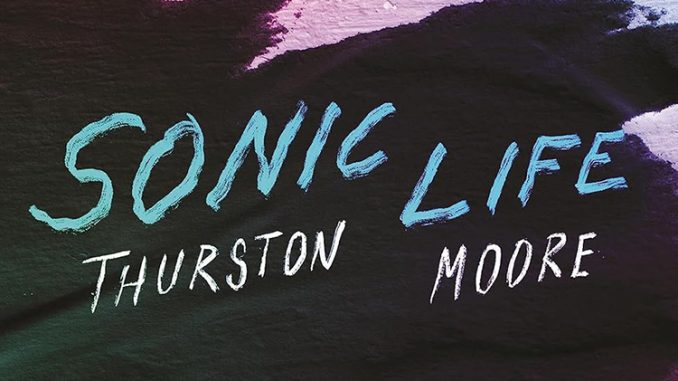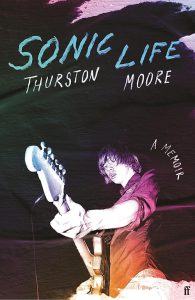
Review by Des Cowley.
Sonic Life: A Memoir – By Thurston Moore (Faber, dist. by Allen & Unwin)
Let’s deal with the elephant in the room first. If you are coming to Thurston’s book hoping for a rejoinder to former wife and bandmate Kim Gordon’s withering account of their 2011 marriage breakdown, recounted in her memoir Girl in a Band, then it’s probably not the book for you. While their split effectively brought down the shutters on Sonic Youth’s thirty-year reign as indie-darlings, his memoir essentially takes the trouble-free route, steering clear of it. Only in its final pages does newfound love Eva Prinz – with whom he now lives, happily married in London – enter the frame, described by Moore as “a vision I had only once dreamed of.” Of the “extreme and difficult” circumstances behind his departure from Kim, he simply states such matters are “intensely personal, and I would never capitalize on them publicly, here or anywhere.” End of story.
So, what’s his book about? In a nutshell, it’s about music, lots and lots of music. Thurston Moore’s love for records and collecting is no secret. When Sonic Youth were in talks with SST Records in 1986, Mike Watt let Thurston know that one of his SST associates was disinclined to sign the band because “record collectors shouldn’t be in bands.” As an inveterate dyed-in-the-wood crate digger, Thurston was cut to the quick, but later determined the argument was pure hog-wash. Moore’s obsessive record-collecting, after all, lies at the heart of his musical eclecticism, he literally has ears for every type of music. A self-confessed fan-boy, he’s never really moved on from being that kid staring fixedly at album covers, praying he’d one-day grow up to be part of it all.
Moore opens his book with a singular memory, of the day his brother came bounding home clutching a copy of ‘Louie Louie’ by the Kingsmen. He was five-years-old, and it was the first time he had heard a song fashioned from guitar, organ, drums. Just like that, he understood that “the energy of our existence would change.” Later, as a teenager, he frequented cheap record store bins – all he could afford – where he discovered the first Stooges’ album. By the time the Stooges’ Raw Power came along, there could be no doubt: “I wanted to not just sound like Raw Power, but I wanted to look the part of the animal on the cover – Iggy with his inimitable, cool stare, a spirit aflame with narcotic transcendence, lusting for beauty and bad behaviour. There was no other – I wanted to be that.”
 Sonic Life is, above all, an account of a life lived in music. It provides a visceral and detailed eye-witness account of the rise of punk and no wave in New York, from the time Moore and his friend Harold first ventured to Manhattan in 1976. What a time to be alive (even though one punter bemoaned to Moore that it was a shame he’d missed the ‘heyday’ of punk). Moore and Harold haunted CBGBs, Max’s Kansas City, Mudd Club, Tier 3, catching the Ramones, New York Dolls, Pattie Smith, Talking Heads, the Cramps, Television, Blondie. Back then, Manhattan was a melting pot, exploding with art, fashion, music, literature. There were experimental films, avant-garde jazz happenings. Philip Glass’s ensemble played uptown, while Jean-Michel Basquiat graffitied the phrase SAMO on buildings downtown. At Dave’s luncheonette, Lydia Lunch, Glenn Branca, Jim Jarmusch, monopolised the booths, joined by a couple of teenagers who later morphed into the Beastie Boys. Moore knew he’d found his people, and by 1978 had moved into the Alphabet City sector of the East Village, an area ‘rife with street crime’.
Sonic Life is, above all, an account of a life lived in music. It provides a visceral and detailed eye-witness account of the rise of punk and no wave in New York, from the time Moore and his friend Harold first ventured to Manhattan in 1976. What a time to be alive (even though one punter bemoaned to Moore that it was a shame he’d missed the ‘heyday’ of punk). Moore and Harold haunted CBGBs, Max’s Kansas City, Mudd Club, Tier 3, catching the Ramones, New York Dolls, Pattie Smith, Talking Heads, the Cramps, Television, Blondie. Back then, Manhattan was a melting pot, exploding with art, fashion, music, literature. There were experimental films, avant-garde jazz happenings. Philip Glass’s ensemble played uptown, while Jean-Michel Basquiat graffitied the phrase SAMO on buildings downtown. At Dave’s luncheonette, Lydia Lunch, Glenn Branca, Jim Jarmusch, monopolised the booths, joined by a couple of teenagers who later morphed into the Beastie Boys. Moore knew he’d found his people, and by 1978 had moved into the Alphabet City sector of the East Village, an area ‘rife with street crime’.
Moore documents his prolonged journey from lone wolf to fully-fledged avant-guitarist, playing in one of the world’s great bands. His earliest gig was at CBGBs, playing with the Coachmen –described as “the tallest art rock band on the downtown scene” – whose songs were “built upon basic chords, albeit through the liberating lens of punk rock, as informed by the Velvet Underground.” The band limped along till 1980, the same year Moore met Lee Renaldo and Kim Gordon.
Moore’s penchant for sonic noise was galvanized by his incessant exposure to extreme music: punk, hardcore, free jazz, the guitar orchestras of Glenn Branca and Rhys Chatham. By the time he, Lee, and Kim formed Sonic Youth, they were already experimenting with unorthodox tunings, which can be heard on their 1982 self-titled mini-album, a snapshot of the band’s sonic radicalism in miniature.
Sonic Life is exhaustive about the who, what and when. So much so, I was convinced Moore must have kept meticulous diaries (turns out no, he researched extensively in libraries, trawling old copies of Village Voice, NME, Melody Maker). But he does exhibit astonishing recall, able to revivify the sheer mayhem of events forty-years ago. Hundreds of names and bands pass through the pages of his book, amounting to a musical detritus of the famous and the forgotten. As a portrait of an exceptional moment in music history, it is compelling and invaluable.
For much of their career, Sonic Youth toured and recorded ceaselessly. There was never much money, at least until the band signed with Geffen, and undertook a support slot on Neil Young’s Ragged Glory world tour. When Nirvana broke, sending major labels scrambling to sign any and every grunge band, Sonic Youth suddenly found themselves elevated to the status of forefathers to this nascent scene. But they took it in their stride, continuing to make music that was difficult and challenging, never cashing in on the potential pay check.
According to Moore, ideal musicians are those that manifest themselves “outside of any ambition toward mainstream acceptance,” specifically those artists that investigate “freshly liberated ideas of drone, psychedelia, jazz, folk, punk, ambient, and electronics, all unifying around a new creative identity.” It is a definition that points to the unrepentant iconoclasm of Sonic Youth. In similar fashion, Moore’s book provides overwhelming testimony that he’s never strayed for a minute from that vision.

